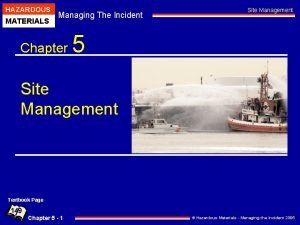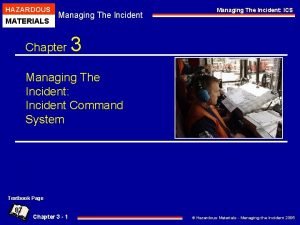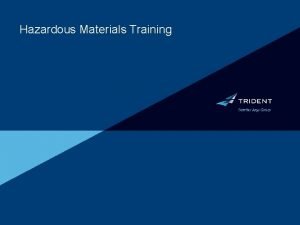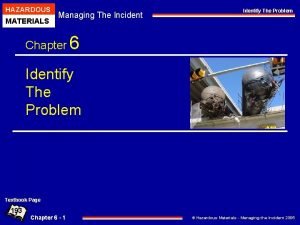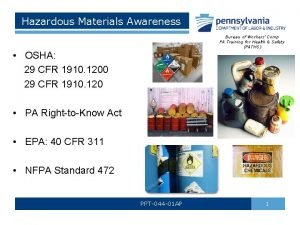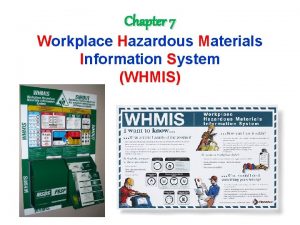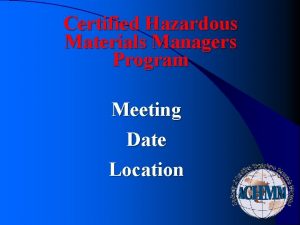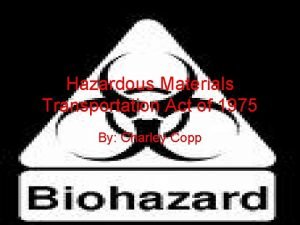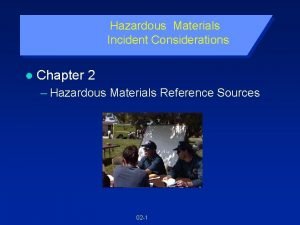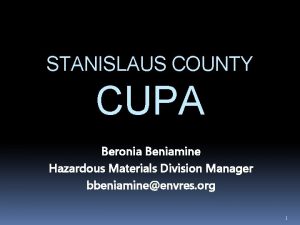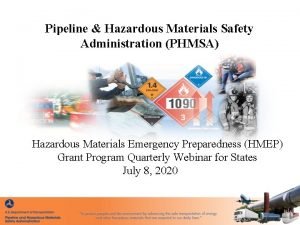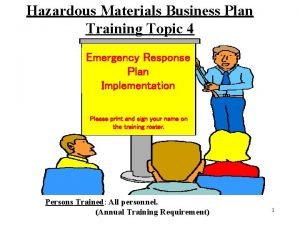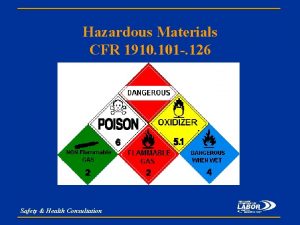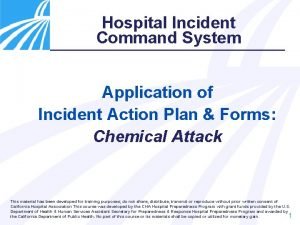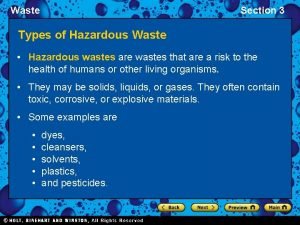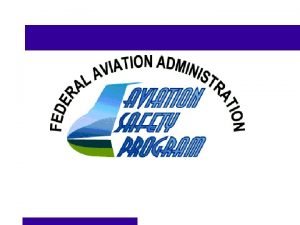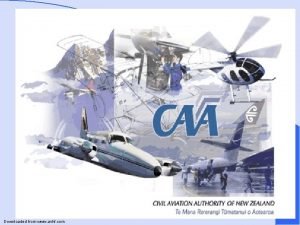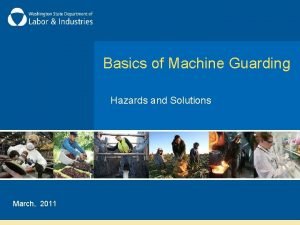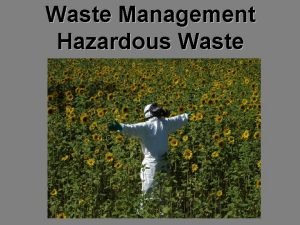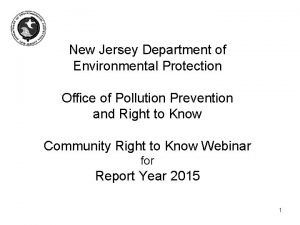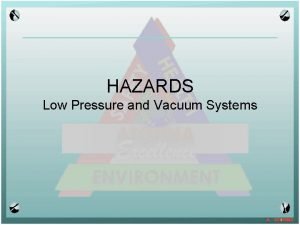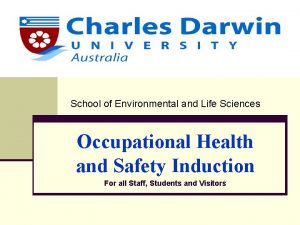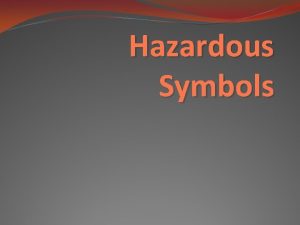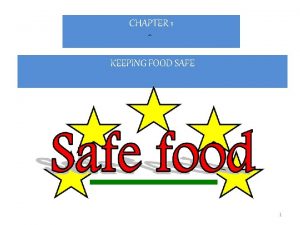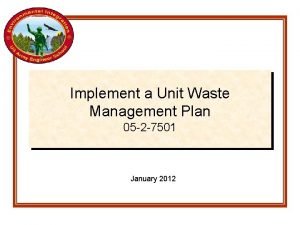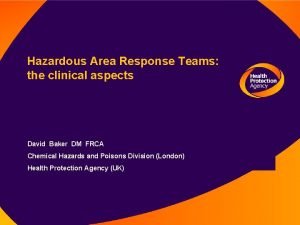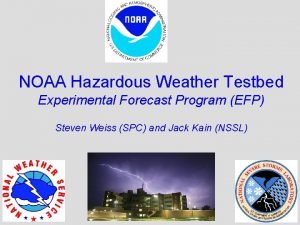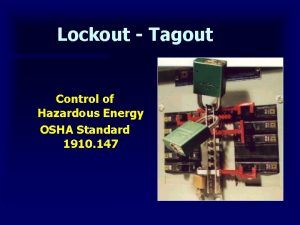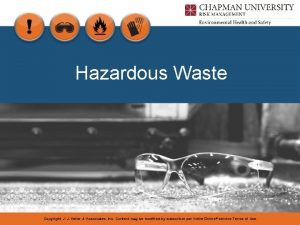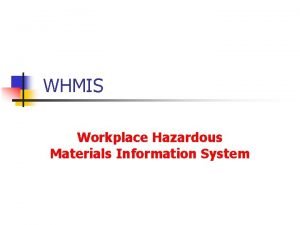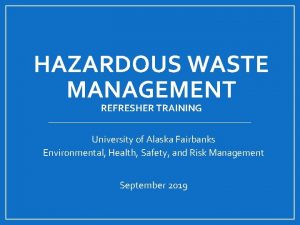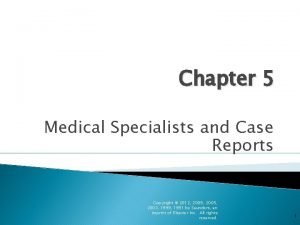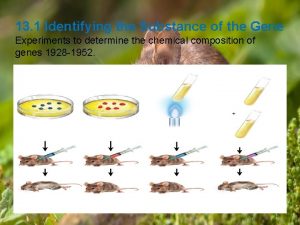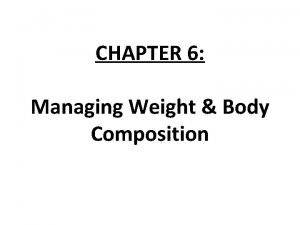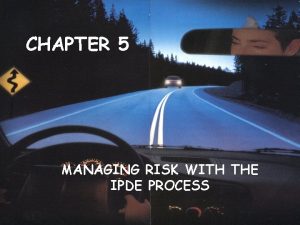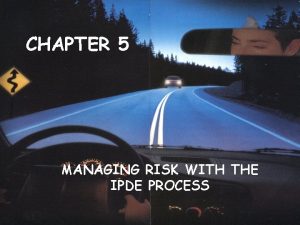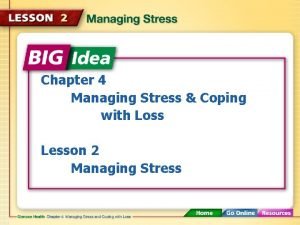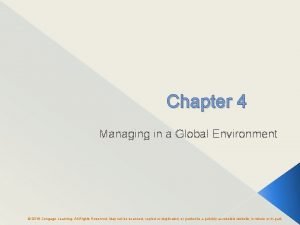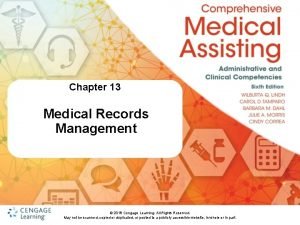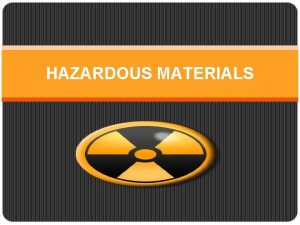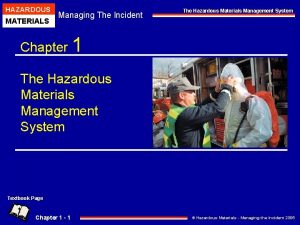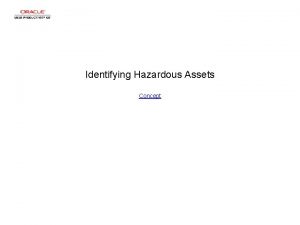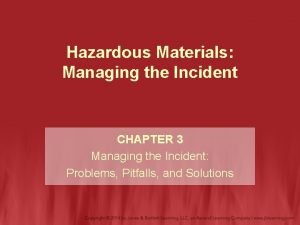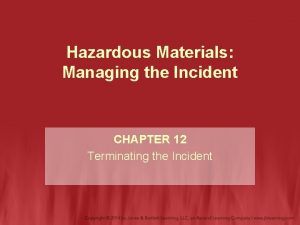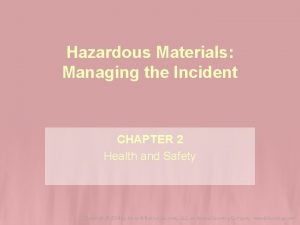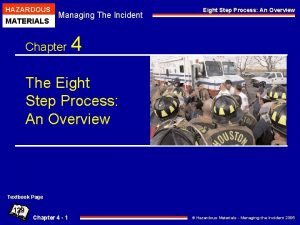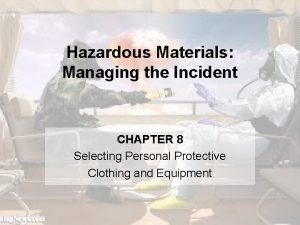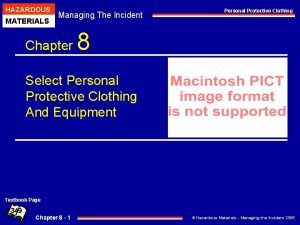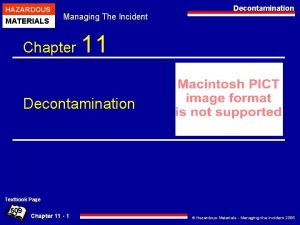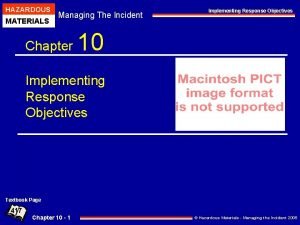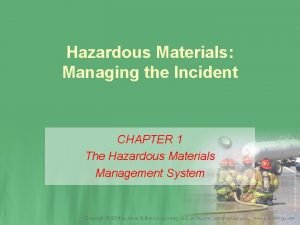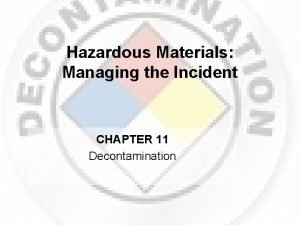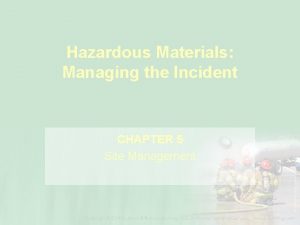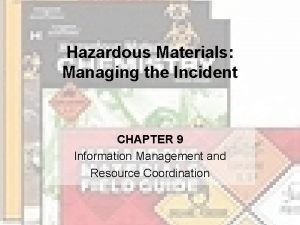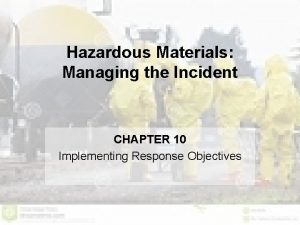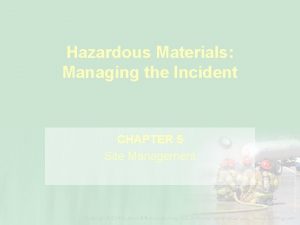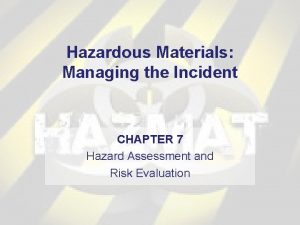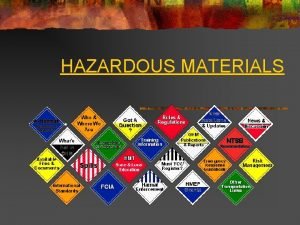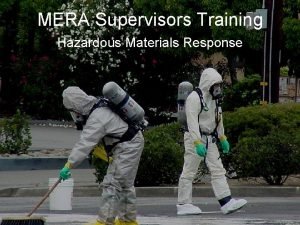Hazardous Materials Managing the Incident CHAPTER 6 Identifying



















































































































- Slides: 115

Hazardous Materials: Managing the Incident CHAPTER 6 Identifying the Problem

Introduction (1 of 2) • Case study: 1971, railroad derailment Houston, Texas https: //youtu. be/4 Sqd. O 0 LYSH 8 • Timely identification and verification of haz-mat are critical to the safe and effective management of a hazmat incident. • Identifying the problem is the second step in the Eight Step Process©.

Introduction (2 of 2) • Identification process begins upon dispatch notification • Responders must first control the incident scene. • Strategic goals and tactical response objectives cannot be formulated until the nature of the problem is defined.

Basic Principles: Knowing the Enemy (1 of 3) • Managing a hazmat incident requires completion of several critical tasks. – Detection of hazmats – Identification of problem and materials – Identification of container and nature of release • Efforts are made difficult by: – Number and variety of hazmats – Criminal and terrorism events

Basic Principles: Knowing the Enemy (2 of 3) • Hazmat trends include: – 75% of releases occur in facilities that produce, store, manufacture, or use chemicals – 25% occur during transportation – Majority involve flammable and combustible liquids and compressed gases – Trailers on flat cars (TOFC) and containers on flat cars (COFC) account for the largest number of rail car movements.

Basic Principles: Knowing the Enemy (3 of 3) • The top hazardous materials transported by rail include: – – – Liquid petroleum gas (LPG) Sodium hydroxide Sulfuric acid Anhydrous ammonia Chlorine Gasoline and blended motor fuels

Basic Principles: Surveying the Incident (1 of 3) • Identification process starts with a survey of the incident site and surrounding conditions. • Identification process basic elements: – Recognition – Identification – Classification

Basic Principles: Surveying the Incident (2 of 3) • With unknown substances, rely on monitoring instruments and chemical analytical kits. • Usually able to determine the hazard class or chemical family • Increasing emphasis on the potential use in terrorism or criminal events

Basic Principles: Surveying the Incident (3 of 3) • Weapons of mass destruction (WMD) scenarios issues: – Use of weapons and armed assaults – Secondary devices – Booby traps • With WMD incidents, the “bad stuff” is still a hazardous material and the basic concepts of recognition, identification, and verification still apply.

Identification Methods and Procedures DANGEROUS TACTICS • Responders may initiate offensive response operations without immediately realizing hazardous materials are involved. • Or may initiate aggressive, offensive operations before the material(s) are positively identified, verified, and evaluated.

Identification Methods and Procedures (1 of 2) • Seven basic identification clues: – – – – Occupancy and location Container shapes Markings and colors Placards and labels Shipping papers and facility documents Monitoring and detection equipment Senses

Identification Methods and Procedures (2 of 2) The closer you are to the problem when identifying the HM involved, the greater your risk of exposure.

Occupancy and Location (1 of 2) • First clue in the standard hazmat identification • Potential locations can be categorized into four basic areas: – – Production Transportation Storage Use • Use the hazard analysis process to determine potential sites.

Occupancy and Location (2 of 2) Hazardous materials locations: the local emergency planning committee (LEPC) and the hazard analysis process are good tools for identifying hazardous materials locations within the plant and community.

Container Shapes (1 of 2) • Second clue in the standard hazmat identification process • Packaging used for transporting hazardous materials is regulated by the DOT. • Other types of containers are used only at fixed facilities, such as process towers, piping systems, and reactors.

Container Shapes (2 of 2) • Packaging is divided into three general groups: – Nonbulk packaging – Bulk packaging – Facility containment systems

Non-bulk Packaging Types • Non-bulk packaging will hold solid, liquid, or gaseous materials. – Liquid - 119 GALLONS – Solid – 882 POUNDS – Gas – W. C. 1, 001 POUNDS • Non-bulk packaging includes: – – – Bags Boxes Carboys Cylinders Drums

Non-bulk Packaging Examples (1 of 3) Bags and Bottles Nonbulk Packaging: Bags. Nonbulk Packaging: Bottles.

Non-bulk Packaging Examples (2 of 3) Drums and Boxes Nonbulk Packaging: Drums. Nonbulk Packaging: Boxes.

Non-bulk Packaging Examples (3 of 3) Carboys and Cylinders Nonbulk Packaging: Multi-cell Packaging. Nonbulk Packaging: Carboys. Nonbulk Packaging: Cylinders.

Bulk Packaging… Ton Containers • Design and Construction – Cylindrical pressure approx. 3’x 8’ with concave or convex – Transport 1 ton (2000 lbs. ) but container weights approx. 1800 lbs. empty – Two identical valves are at one end under a protective hood • Valves should be at the “ 12 o’clock” position for vapor under normal operation • Valves should be at the “ 6 o’clock” position for liquid under normal operation • Chlorine and sulfur dioxide have fusible plugs – phosgene have no pressure relief devices – Usually transported on flat bed vehicles

Bulk Packaging… Ton Containers • Contents and Hazards – Liquefied gases • • Chlorine Sulfur Dioxide Phosgene Non-flammable fluorocarbon refrigerated gases – Containers with convex design usually contain refrigerant gases – Containers with concave design usually contain chlorine, phosgene, etc…

Flexible Containers, Rigid Containers, and Portable Bin Flexible Containers or “Super Sacks”. Rigid Containers—Polyethlene and Steel Tanks or "Totes. ” Portable Bin .

Bulk Packaging – Intermediate Bulk Containers (IBCs)…Bags • Design and Construction – Constructed of flexible material • Polypropylene • Cloth • Woven fabric – Bags may be found in boxes – Sizes range from 15 – 85 ft³ with weights of 500 to 5000 lbs. – Transported in both open and closed vehicles – Bags may be palletized or hung inside of vehicles

Bulk Packaging… Intermediate Bulk Containers (IBC)… Bags • Contents and Hazards – Solid materials • Explosives, flammable solids, oxider, organic peroxides poisons and corrosives – Fertilizers – Pesticides – Caustic powders – Water treatment chemicals – Class 9 materials • Not authorized for liquid HAZMAT except under DOT exemptions – Large reinforced rubber bladders used for transports of non-hazardous materials

Bulk Packaging. . . Intermediate Bulk Containers (IBC) … Rigid containers – Polyethylene & Steel “Totes” • Design and Construction – Consist of polyethylene inside of a steel frame • Top tank filling • Top and bottom discharge piping – Approx. 4’x 6’ with a capacity of 300 to 500 gals. – Polyethylene tank may separate from framing, creating mechanical stress & container failure

Bulk Packaging –Portable Bins • Design and Construction – – Constructed of steel or stainless steel Approx. 4’x 6’ similar to IBC tanks May weight 3+ tons Transported usually but flat bed vehicles • Contents and Hazards – Liquid materials including corrosives and Class 9 materials

Cargo Tank Trucks

Bulk Packaging – Cargo Tank Truck. . Makings • Manufacture Spec. Plate should be mounted on the front third on the lefts side (tanks made before July 1 st 1985 will be found on the right side). The plate should include the following: – – – – Name of Manufacturer, Serial #, and date of manufacture DOT specification # (e. g. MC-306/DOT-406) Material of construction (including welds, liners, and headshell) Max. allowable working pressure (MAWP) Compartment capacity (front to rear) Water capacity in lbs. (1 gal. = 8. 33 lbs. ) Max. product load Max. safety temperature

Bulk Packaging – Cargo Tank Truck. . Makings • Some tanks will have multiple uses and have two specification plates – Plates are color coated • • MC-306/DOT-406 – red plate and fittings MC-307/DOT-407 – green plate and fittings MC-312/DOT-312 – yellow plate and fittings Non-specific tanks – blue plate and fittings – A covering on a slide will cover the plate not in current use, but keep in mind that the plate may slide due to an accident or improperly positioned by the driver.

Bulk Packaging – Cargo Tank Truck. . Makings • Construction materials – – – AL – aluminum CS – carbon steel HSLA – high strength low alloy steel HSLA-QT – high strength low alloy, quenched and tempered steel MS – mild steel SS – stainless steel • ASME containers – Some cargo tanks have been tested to the American Society of Mechanical Engineers (ASME) – Tank will have a second plate outlining the requirements. – Identified by a “U” in the upper left corner of the plate.

Bulk Packaging – Cargo Tank Truck. . Makings • Inspection markings – All tanks are subject to inspections and can be found on the front near the manufactures specifications plate – Inspection markings • • • V – external visual inspections I – internal visual inspections K – leakage test L – lining inspection P – pressure test T – Thickness test • MC-331 markings are stenciled near the spec. plate – QT – quenched tempering – NQT – non-quenched tempering

Bulk Packaging – Cargo Tank Truck • Design and Construction of MC-306/DOT-406 Atmosphere pressure (less than 4 psi) – – – Oval cross section Max. of 5 compartment Max. capacity of 9000 gals. US 13, 800 Canada Valves can be air or cable operated Safety features (on most tanks) • • Emergency remote shut off Vacuum relief protection Overturn protection Vapor emission controls

Bulk Packaging – Cargo Tank Truck • Contents and Hazards of MC-306/DOT-406 Atmosphere pressure (less than 4 psi) – Flammable & combustible liquids • Gasoline • Diesel fuel

Bulk Packaging – Cargo Tank Truck • Design and Construction of MC-307/DOT-407 Low Pressure Chemical Tank (up to 40 psi) – – – – Circular in cross section May have rings to strengthen the tank Horseshoe shape in insulated tanks which may cover the rings Max. 5 compartments Max. 40 psi Capacity of 5000 – 8000 gals. Valves may be air, hydraulic, or cable operated

Bulk Packaging – Cargo Tank Truck • Contents and Hazards MC-307/DOT-407 Low Pressure Chemical Tank (up to 40 psi) – – Flammable & combustible liquids Poisons Mild corrosives Chemicals have Vapor pressure of 18 psi @ 100 degrees, but not more than 40 psi @ 170 degrees

Bulk Packaging – Cargo Tank Truck • Design and Construction of MC-312/DOT 412 Corrosive tank – – – – Narrow circular cross sections Horseshoe shape on insulated version that will conceal support rings Single compartment Capacity of 3300 – 6500 gals. MAWP 40 – 50 psi Valves may be manual, air or hydraulic. Does NOT have a remote emergency shut off

Bulk Packaging – Cargo Tank Truck • Contents and Hazards of MC-312/DOT 412 Corrosive tank – Corrosives – High density liquids

Bulk Packaging – Cargo Tank Truck • Design and Construction of MC-307/DOT-407 Low Pressure Chemical Tank (up to 40 psi) – – – – Circular in cross section May have rings to strengthen the tank Horseshoe shape in insulated tanks which may cover the rings Max. 5 compartments Max. 40 psi Capacity of 5000 – 8000 gals. Valves may be air, hydraulic, or cable operated

Bulk Packaging – Cargo Tank Truck • Design and Construction of MC-330/MC-331 High pressure tank – – – Single compartment Seamless or welded steel Circular shape Pressure range 100 -500 psi Range of capacity 2300 – 3000 gals. (bobtail) 9000 – 14, 500 gals. Valves may be air or cable operated

Bulk Packaging – Cargo Tank Truck • Contents and Hazards of MC-330/MC-331 – Liquefied gases • Propane • Butane • Anhydrous ammonia

Bulk Packaging – Cargo Tank Truck • Design and Construction of MC-338 Cryogenic liquid tanks – – – Large well insulated “thermos bottle” design Work box usually at the rear that enclose the valves Evaporator coils underneath the tank Pressure range of 25 – 500 psi Capacity of 8000 – 10, 000 gals. If transporting gases naturally in air it is designed to vent off during transport

Bulk Packaging – Cargo Tank Truck • Contents and Hazard of MC-338 – Cryogenic liquids • • Liquid oxygen Liquid nitrogen Ethylene Liquid carbon dioxide

Bulk Packaging – Cargo Tank Truck • Design and construction of compressed gas trailer – Consist of 2 – 20 seamless steel cylinders – Service pressures from 2000 – 5000 psi – Valves, piping and controls are typically at the rear of the trailer

Bulk Packaging – Cargo Tank Truck • Contents and Hazards of compressed gas trailers – Pressurized gases • • Oxygen Hydrogen Nitrogen Helium – Commonly found at construction and industrial sites

Intermodal Portable Tank Containers/Tank Containers or ISO-Tanks. Intermodal Portable Tank Markings.

Bulk Packaging – Intermodal Portable Tank • Design and Construction – Single vessel (no compartment within tank) with a metal support frame – Majority are approx. 20’ long 8’ wide 8 -9’ high – Two basic types • Box type with a cage like framework • Beam type that relies upon the strength of the tank – Emergency remote shut off device is at the bottom outlet valves – May be lined, insulated, jacketed, have refrigeration unit, or be heated

Bulk Packaging – Intermodal Markings • Common Sizes – 20 = 20’ (8’ high) – 22 = 20’ (8’ 6” high) – 24 = 20’ (> 8’ 6” high) • Non-Hazardous Commodities – – • T T 0 =. 44 (6. 4 psig) Bar test T 1 =. 44 – 1. 47 (6. 4 to 21. 3 psig) Bar test T 2 = 1. 47 – 2. 94 (21. 3 – 42. 6 psig) Bar test T 3 = spare Hazardous Commodities – – – T 4 = <1. 47 Bar test T 5 = 1. 47 – 2. 58 (21. 3 – 37. 4 psig) Bar test T 6 = 2. 58 – 2. 94 (37. 4 – 42. 6 psig) Bar test T 7 = 2. 94 – 3. 93 (42. 6 – 57 psig) Bar test T 8 = >3. 93 (57 psig) Bar test T 9 = spare Four digit code that follows the country of origin Note: 1 Bar = 14. 5 PSI

Bulk Packaging – Intermodal Portable Tank • Design and Construction – Max. pressure of up to 100 psi – Normal capacities range from 5000 psi to 6340 gals. – Two basic types of non-pressure containers • IM-101 – pressures range from 25. 4 – 100 psi • IM-102 – pressures range from 14. 5 – 24. 4 psi – Valves & fittings found in the top spill box and may have the following: • • Man way Dipstick Airline connections Relief devices – May be top or bottom load and unloaded

Pressure and Non-Pressure Tank Containers Intermodal Portable Tank Containers.

Bulk Packaging – Intermodal Portable Tank • Contents and Hazards – IM 101 Tanks • • Transport both hazardous and non-hazardous liquid materials Flammable liquids with flash points < 32 degrees F Poisons Corrosives – IM 102 tanks • • • Transport both hazardous and non-hazardous liquid materials Flammable liquids with flash points from 32 degrees to 140 degrees F Whiskey, alcohols Poison liquids Food grade commodities Corrosives

Railroad Tank Cars (1 of 2) Railroad Tank Cars: Markings

Railroad Tank Cars (2 of 2) Railroad Tank Cars: DOT Specification Markings

Railroad Tank Cars Markings

Railroad Tank Cars Markings

Bulk Packaging – Railroad Tank Car • Design and Construction of the Non-pressure tanks – – – – Fittings and valves are visible on top of the tank Tank pressures 60 -100 psi Capacity of 4000 – 45, 000 gals. Determined by markings Up to 6 compartments May have bottom unload valve If hauling corrosives will have a vertical paint strip at the manway Safety features include pressure and vacuum relief valves, shelf couplers, head shields, and thermo protection (on most tank cars)

Bulk Packaging – Railroad Tank Car • Contents and Hazards of the Non-pressure tanks – – – – Transports liquids and solids with VP below 25 psi @ 105 -115 degrees Flammable & combustible liquids and solids Reactive liquids and solids Oxidizers Organic peroxides Liquid poisons Corrosives Non-hazardous liquids • Corn syrups • Vegetable oil

Bulk Packaging – Railroad Tank Car • Design and Construction of pressure cars – – – Cylindrical tank Fittings and valves enclosed in a protective housing Pressures from 100 – 600 psi Capacity from 4000 – 45, 000 gals. Thermal protection is required when hauling flammable liquefied gases

Bulk Packaging – Railroad Tank Car • Contents and Hazards of pressure cars – Flammable & non-flammable gases – Poisonous compressed gases • • LPG Chlorine Anhydrous hydrogen fluoride (orange & red strip in middle of the car) Hydrocyanic acid (red & white strip in the middle of the car) – Any color schemes are an industrial standard NOT a DOT standard

Bulk Packaging – Railroad Tank Car • Design and Construction of Cryogenic liquid tank car – Well insulated (Thermos bottle) – Transports low pressure refrigerating liquids > 25 psi can be up to 175 psi – Capacity based on markings – Absence of any top fittings or protective housing – Fittings and valves in box on the side or ends of the car

Bulk Packaging – Railroad Tank Car • Contents and Hazards – Gases liquefied through refrigeration rather than pressure < -130 degrees – Insulation only protects product for only 30 days (time sensitive loads) – Examples • Ethylene • Liquid argon • Liquid hydrogen

Bulk Packaging – Railroad Tank Car • Design and Construction of Tank train – Series of non-pressure tank cars interconnected with flexible hoses to allow loading and unloading of cars from one end – Hoses are purged after loading and unloading and valves closed before transport

Facility Containment Systems (1 of 5) • Facility containment systems include: – Pressurized and nonpressurized storage tanks – Process towers – Chemical and nuclear reactors – Piping systems – Pumps – Storage bins and cabinets – Dryers and degreasers – Machinery

Facility Containment Systems (2 of 5) Atmospheric Pressure Liquid Open Floating Roof Tank With Geodesic Dome Covered Floating Roof Tank Open Floating Roof Tank

Facility Containment Systems • Examples may include – – – storage tanks process towers chemical & nuclear reactors piping systems, pumps storage bins & cabinets • Common facility storage tanks and vessels: – Atmospheric and low pressure liquid storage tanks – Pressurized storage vessels 230

*Atmospheric Pressure Liquid – Cone Roof • Design And Construction – Welded steel tank with vertical cylinder walls supporting a fixed bottom and flat or conical roof – Typical sizes • 20 -200 ft. diameter – 420, 000 gals. or 10, 000 barrels (1 barrel = 42 gals. ) – Vapor space between the liquid level and the roof and pressure vacuum valve for “breathing” during transfer

Atmospheric Pressure Liquid – Cone Roof • Contents and Hazards – – Flammable and combustible liquids Solvents Oxidizers Corrosives

*Atmospheric Pressure Liquid – Covered Floating Roof • Design And Construction – Cone roof tank with an internal floating roof – Identified by the large “eyebrow” vents at the top of the tank shell – Typically 40 – 300 ft. in diameter and up to 500, 000+ gals

Atmospheric Pressure Liquid – Covered Floating Roof • Contents and Hazards – Flammable & combustible liquids – High VP products due to environmental emissions

*Atmospheric Pressure Liquid – Open Floating Roof • Design And Construction – Steel tank with vertical cylindrical walls and the roof that floats on the surface of the product – No vapor space except at the lowest levels when the roof rest on the roof supports

Atmospheric Pressure Liquid – Open Floating Roof • Contents and Hazards – Flammable and combustible liquids – Petroleum storage – Higher vapor pressure materials

*Atmospheric Pressure Liquid – Open Floating Roof – Geodesic Dome • Design And Construction – Essentially the same as an open floating roof with a light weight aluminuim geodesic dome

Atmospheric Pressure Liquid – Open Floating Roof – Geodesic Dome • Contents and Hazards – Flammable and combustible liquids – Petroleum facilities – Higher VP products

*Low Pressure Liquid – Vertical Storage Tank • Design And Construction – – Steel tanks referred to as dome roof tanks Capacity of 100 – 10, 000 gals. Pressures of 2. 5 to 15 psi Smaller fiberglass tanks may be found in chemical services • Contents and Hazards • Similar to atmospheric tanks

Low Pressure Liquid – Horizontal Storage Tank • Design And Construction – Steel tanks encased in fire retardant material (tank in tank design) – Capacity of 300 -10, 000 gals – NFPA standards may apply to certain products • Contents / Hazard Classes – Similar to atmospheric tanks

High Pressure Storage Tanks – Horizontal Storage Tank • Design And Construction – Single shell non-insulated constructed to ASME standards – Pressure 100 – 500 psi & capacity range from 100 to 120, 000 gals. – Piping includes both liquid and vapor lines • Contents / Hazard Classes – Flammable and non-flammable liquids • • LPG Anhydrous ammonia Chlorine Vinyl chloride

High Pressure Storage Tanks – Spherical Tank • Design And Construction – Single shell non-insulated constructed to AMSE standards – Pressure from 100 -500 psi – capacity up to 600, 000 gals – Piping for both liquid and vapor lines • Contents / Hazard Classes – Flammable & non-flammable liquefied gas

High Pressure Storage Tanks – Underground Storage Tank • Design And Construction – Single shell constructed with AMSE standards – Pressure from 100 -500 psi, capacity up to 10, 000+ gals. – Most common are 2000 gals propane • Contents / Hazard Classes – Liquefied petroleum gases • Propane • Butane • Mixture

High Pressure Storage Tanks – Cryogenic Liquid • Design And Construction – Large well insulated “thermos bottle” – Pressures up to 250 psi, and a capacity of up to 20, 000 gal. – Liquefied oxygen is always set on concrete not asphalt • Contents / Hazard Classes – Cryogenic liquids • Liquid oxygen • Liquid nitrogen

High Pressure Storage Tanks – Refrigerated Storage Tank • Design And Construction – – Single or double steel walls Working pressure <15 psi Product stored near their boiling points Up to 200, 000+ gals. • Contents / Hazard Classes – Liquefied gases – Found in pipeline terminals – Utility plants

Facility Containment Systems • Facility containment systems are packaging, containers, and/or associated systems that are part of a fixed facility’s operations and can include: – – – – Storage tanks Process towers Chemical and nuclear reactors Piping systems Pumps Storage bins and cabinets Dryers and degreasers Machinery

Radioactive Material Packaging (1 of 3) • The transport of radioactive materials is based on the philosophy that: – Safety should be primarily focused on the package (i. e. , packaging is the first line of defense). – Package integrity should be directly related to the degree of hazard of the material it contains.

Radioactive Material Packaging (2 of 3) • Five basic types of radioactive material packaging: – – – Excepted packaging Industrial packaging Type A packaging Type B packaging Type C packaging

Radioactive Material Packaging Type A Packaging Type B Packaging

Radioactive Material Packaging (3 of 3) Responders must be familiar with the basic types of radioactive material packaging.

Markings and Colors (1 of 2) • Third clue in the standard hazmat identification process • These clues may include: – Color codes – Container specification numbers – Signal words – The content’s name – Associated hazards

Markings and Colors (2 of 2) • At facilities, clues may include: – Hazard communication markings – Piping color code systems – Specific signs and/or signal words (e. g. , “Hydrofluoric Acid Area”) • Markings and colors can be used as a clue for hazmat recognition, identification, and classification.

Non-bulk Package Markings (1 of 2) • Container markings include: – – – – Toxicity signal word Statement of practical treatment Physical or chemical hazard statement Product name Ingredient statement Environmental information EPA registration number EPA establishment number

Non-bulk Package Markings (2 of 2) • Chemical abstract service (CAS) number – Found on hazardous materials containers – Used to track chemicals in the community – Sometimes referred to as a chemical’s “social security number” • Cylinder color codes – There are several voluntary color schemes.

Bulk Packaging and Transportation Markings (1 of 5) • Four-digit identification numbers are assigned to a hazardous material or group of hazardous materials. • Inhalation hazard markings – Poison−inhalation hazard – Inhalation hazard • Marine pollutant markings – Mark must appear when the package moves by water.

Bulk Packaging and Transportation Markings (2 of 5)

Bulk Packaging and Transportation Markings (3 of 5) • Elevated temperature materials – Liquids at or above 212˚F (100˚C) – Liquids with a flash point at or above 100˚F (37. 8˚C) – Solids at a temperature at or above 464˚F (240˚C) • Except for a bulk container transporting molten aluminum or molten sulfur (which must be marked “MOLTEN ALUMINUM” or “MOLTEN SULFUR”)

Bulk Packaging and Transportation Markings (4 of 5) • Pipelines – Safest and second largest hazmat transportation mode – Used for both intrastate and interstate transportation • Transporting between industrial facilities • Transferring raw materials and finished products within oil, chemical, and petrochemical facilities • Delivering liquid and gas fuels directly to the consumer

Bulk Packaging and Transportation Markings (5 of 5) Pipeline markers must provide the pipeline contents, the pipeline operator, and an emergency telephone number.

Facility Markings NFPA 704 System HEALTH FLAMMABILITY REACTVITY SPECIAL HAZARDS 3 4 2 OX

Facility Markings (2 of 3) • In 2013, OSHA adopted the Global Harmonization System (GHS). • Three main elements – Classification system – Labeling – A prescribed hazard statement assigned to each hazard category along with a signal word requirement (“Danger” or “Caution”)

Facility Markings (3 of 3) • U. S. Military Marking System – Found primarily on both structures and containers at U. S. military facilities – Consists of both fire and chemical hazard symbols

Placards and Labels (1 of 3) • Fourth clue in the standard hazmat identification process • Placards and labels provide recognition and general hazard classification by way of: – – Colored background Respective hazard class symbol Hazard class/division number Hazard class description wording or the four-digit identification number

Placards and Labels (2 of 3) Placards and labels are the fourth clue in the standard identification process and provide hazard communication information in several manners.

Shipping Papers and Facility Documents • Fifth clue in the standard identification process • Required in transport vehicles • Responders should be familiar with: – Information noted – Location kept – Responsible party

Shipping Paper Requirements • Required information: – – – – Proper shipping name DOT hazard class/division number Subsidiary hazard class Identification number(s) Packing group Total quantity Emergency contact

Shipping Papers: Additional Entries (1 of 3) • Additional entries may be required for some hazardous materials and include: – – – – Compartment notation Empty packaging HOT Technical name Not otherwise specified (NOS) Subsidiary hazard class Reportable quantity (RQ) notation Marine pollutant

Shipping Papers: Additional Entries (2 of 3) • • • EPA waste stream number EPA waste characteristic number Radioactive material information Poison notation Poison−inhalation hazard (PIH)or toxicinhalation hazard (TIH) • Hazard zone • Dangerous when wet notation

Shipping Papers: Additional Entries (3 of 3) • • • Limited quantity Canadian information Placard notation Trade name DOT exemption notation Hazardous materials STCC number – Standard Transportation Commodity Code • Shipper contact

Shipping Papers: Emergency Response Information • Emergency response information must provide the following: – – – Brief product description Emergency actions involving fire Emergency actions involving release only Personnel protective measures Environmental considerations, as appropriate First-aid measures

Facility Documents • Facility document examples include: – – – Hazmat inventory forms Shipping and receiving forms Risk Management Plans Supporting documentation SDSs Tier II reporting forms required to be submitted to the LEPC and the fire department under SARA Title III

Monitoring and Detection Equipment (1 of 2) • Sixth clue in the standard identification process • Can provide data concerning nature of the problem and specific materials involved • Essential for identifying, verifying, or classifying the hazmat(s) involved

Monitoring and Detection Equipment (2 of 2) • Monitoring helps responders to: – Determine the appropriate levels of personal protective clothing and equipment – Determine the size and location of hazard control zones – Develop protective action recommendations and corridors – Assess the potential health effects of exposure

Senses (1 of 2) • • Final clue in the standard identification process Not a primary identification tool Visual and hearing offer some protection. Examples: – Smells – Dizziness – Unusual noises (i. e. , relief valve actuations) – Destroyed vegetation

Senses (2 of 2) • Always avoid inhalation (or smelling). • Remember basic street smart clues of IDLH atmospheres: – – – Visible vapor clouds Releases Large liquid leaks Below grade or confined spaces Dead birds, brown foliage, sick animals, and sick humans – Trust your instincts.

Summary (1 of 5) • Critical tasks in managing a hazmat incident are: – – Surveying the incident scene Identifying the problem and material Identifying the type of hazmat container Identifying the nature of its release • Identification process basic elements: – Recognition – Identification – Classification

Summary (2 of 5) • The seven basic clues for recognition, identification, and classification are: – – – – Occupancy and location Container shapes Markings and colors Placards and labels Shipping papers and facility documents Monitoring and detection equipment Senses

Summary (3 of 5) • Responders should be able to recognize container profiles and know the general hazmat class/division of materials found within each type of container.

Summary (4 of 5) • Markings and colors may include: – – – Color codes Container specification Numbers Signal words The content’s name and associated hazards

Summary (5 of 5) • Responders must be familiar with: – The information noted on shipping papers – Their location on each transport vehicle – The individual responsible for them • Various types of facility documents can be a source for hazmat recognition, identification, and classification at an emergency.
 Hazardous materials managing the incident
Hazardous materials managing the incident Hazardous materials managing the incident
Hazardous materials managing the incident Hazardous materials incident report
Hazardous materials incident report 49 cfr parts 171-179
49 cfr parts 171-179 Hazardous materials table
Hazardous materials table Us military marking system for hazardous materials
Us military marking system for hazardous materials Pa-psfa-hazardous materials awareness
Pa-psfa-hazardous materials awareness Shape and color of whmis 2015 symbols
Shape and color of whmis 2015 symbols Chmm accreditation training
Chmm accreditation training Hazardous materials transportation act of 1975
Hazardous materials transportation act of 1975 Hazardous materials reference books
Hazardous materials reference books Stanislaus county hazardous waste
Stanislaus county hazardous waste Pipeline and hazardous materials administration
Pipeline and hazardous materials administration Hazardous materials business plan
Hazardous materials business plan Compressed gas association pamphlet p 1 1965
Compressed gas association pamphlet p 1 1965 Identifying and non identifying adjective clauses
Identifying and non identifying adjective clauses Whats an adjective clause
Whats an adjective clause Information essential
Information essential Incident objectives that drive incident operations
Incident objectives that drive incident operations Identifying and managing project risk tom kendrick
Identifying and managing project risk tom kendrick Useful and harmful materials pictures
Useful and harmful materials pictures Blocking of light of materials
Blocking of light of materials Cant stop the feeling trolls go noodle
Cant stop the feeling trolls go noodle Man made map
Man made map Adopting materials
Adopting materials Direct materials budget with multiple materials
Direct materials budget with multiple materials Section 3 hazardous waste answers
Section 3 hazardous waste answers Aviation hazardous attitudes
Aviation hazardous attitudes Bio medical waste management introduction
Bio medical waste management introduction Avhf
Avhf Aviation hazardous attitudes
Aviation hazardous attitudes Six types of machine guarding
Six types of machine guarding E-waste definition apes
E-waste definition apes Sample of hazardous waste
Sample of hazardous waste Nj crtk environmental hazardous substances
Nj crtk environmental hazardous substances Low pressure hazardous vacuum switch
Low pressure hazardous vacuum switch Hazardous area training darwin
Hazardous area training darwin Hazardous symbols
Hazardous symbols Keeping food safe chapter 1
Keeping food safe chapter 1 Hazardous drug api
Hazardous drug api On july 18 2001 a train carrying hazardous chemicals
On july 18 2001 a train carrying hazardous chemicals Segregation of hazardous waste
Segregation of hazardous waste Hazardous area response team
Hazardous area response team Hazardous movement asl
Hazardous movement asl Solid and hazardous waste
Solid and hazardous waste Noaa experimental forecast
Noaa experimental forecast Hazardous energy
Hazardous energy Keller hazardous waste disposal
Keller hazardous waste disposal What are the 3 things required on a workplace label
What are the 3 things required on a workplace label Hazmat training alaska
Hazmat training alaska Chapter 37 identifying career opportunities
Chapter 37 identifying career opportunities Identifying market segments and targets chapter 9
Identifying market segments and targets chapter 9 Identifying market segments and targets
Identifying market segments and targets Identifying market segments and targets chapter 9
Identifying market segments and targets chapter 9 Identifying medical specialties chapter 7
Identifying medical specialties chapter 7 Chapter 13 lesson 1 identifying the substance of the gene
Chapter 13 lesson 1 identifying the substance of the gene Hình ảnh bộ gõ cơ thể búng tay
Hình ảnh bộ gõ cơ thể búng tay Lp html
Lp html Bổ thể
Bổ thể Tỉ lệ cơ thể trẻ em
Tỉ lệ cơ thể trẻ em Chó sói
Chó sói Tư thế worms-breton
Tư thế worms-breton Chúa sống lại
Chúa sống lại Các môn thể thao bắt đầu bằng tiếng chạy
Các môn thể thao bắt đầu bằng tiếng chạy Thế nào là hệ số cao nhất
Thế nào là hệ số cao nhất Các châu lục và đại dương trên thế giới
Các châu lục và đại dương trên thế giới Công thức tiính động năng
Công thức tiính động năng Trời xanh đây là của chúng ta thể thơ
Trời xanh đây là của chúng ta thể thơ Cách giải mật thư tọa độ
Cách giải mật thư tọa độ Phép trừ bù
Phép trừ bù độ dài liên kết
độ dài liên kết Các châu lục và đại dương trên thế giới
Các châu lục và đại dương trên thế giới Thể thơ truyền thống
Thể thơ truyền thống Quá trình desamine hóa có thể tạo ra
Quá trình desamine hóa có thể tạo ra Một số thể thơ truyền thống
Một số thể thơ truyền thống Bàn tay mà dây bẩn
Bàn tay mà dây bẩn Vẽ hình chiếu vuông góc của vật thể sau
Vẽ hình chiếu vuông góc của vật thể sau Nguyên nhân của sự mỏi cơ sinh 8
Nguyên nhân của sự mỏi cơ sinh 8 đặc điểm cơ thể của người tối cổ
đặc điểm cơ thể của người tối cổ V cc
V cc Vẽ hình chiếu đứng bằng cạnh của vật thể
Vẽ hình chiếu đứng bằng cạnh của vật thể Fecboak
Fecboak Thẻ vin
Thẻ vin đại từ thay thế
đại từ thay thế điện thế nghỉ
điện thế nghỉ Tư thế ngồi viết
Tư thế ngồi viết Diễn thế sinh thái là
Diễn thế sinh thái là Dạng đột biến một nhiễm là
Dạng đột biến một nhiễm là Bảng số nguyên tố
Bảng số nguyên tố Tư thế ngồi viết
Tư thế ngồi viết Lời thề hippocrates
Lời thề hippocrates Thiếu nhi thế giới liên hoan
Thiếu nhi thế giới liên hoan ưu thế lai là gì
ưu thế lai là gì Hổ đẻ mỗi lứa mấy con
Hổ đẻ mỗi lứa mấy con Khi nào hổ con có thể sống độc lập
Khi nào hổ con có thể sống độc lập Sơ đồ cơ thể người
Sơ đồ cơ thể người Từ ngữ thể hiện lòng nhân hậu
Từ ngữ thể hiện lòng nhân hậu Thế nào là mạng điện lắp đặt kiểu nổi
Thế nào là mạng điện lắp đặt kiểu nổi Chapter 1 managing risk when driving
Chapter 1 managing risk when driving Chapter 8 managing stress and anxiety
Chapter 8 managing stress and anxiety Leasiest
Leasiest Chapter 8 activity 8-2 distraction factions answers
Chapter 8 activity 8-2 distraction factions answers Chapter 8 managing distractions answers
Chapter 8 managing distractions answers Chapter 6 managing weight and body composition
Chapter 6 managing weight and body composition When you apply the ipde process
When you apply the ipde process Chapter 4 managing risk with the ipde process
Chapter 4 managing risk with the ipde process Chapter 4 managing stress and coping with loss
Chapter 4 managing stress and coping with loss Explain what is meant by selective use of the ipde process
Explain what is meant by selective use of the ipde process Chapter 4 managing in a global environment
Chapter 4 managing in a global environment Chapter 18 managing anxiety
Chapter 18 managing anxiety Chapter 17 managing personal finances
Chapter 17 managing personal finances Ch 17 mini sim on managing business finances
Ch 17 mini sim on managing business finances Chapter 16 managing the stress in your life
Chapter 16 managing the stress in your life Managing medical records chapter 13
Managing medical records chapter 13 Most fad diets do follow the mypyramid guidelines.
Most fad diets do follow the mypyramid guidelines. Chapter 11 lesson 2 body image and eating disorders
Chapter 11 lesson 2 body image and eating disorders
